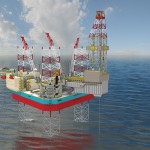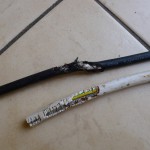
Among the various possible environments, the so-called “harsh environment “ is where the capabilities of a cable of keeping its characteristics unchanged in time can be more easily damaged

Wherever the public can accidentally get in touch with wirings, for instance in the transport ambit, they privilege safety aspects, such as flammability and presence of halogens.
The growing complexity of applications, the need of optimizing the performances of components with an ever-growing number of functions and the difficulty of implementing solutions able to grant adequate production and efficiency levels at low costs in whatever conditions, attract the attention on several fronts, with the wiring that is almost taken for granted or anyway not deemed a potential source of troubles. If a cable deteriorates, however, if a line stops functioning, we cannot exclude that an entire system, even if attentively conceived, might stop. The reliability of a cable is essentially based on two factors: long service life or durability, and integrity of the signals that are transmitted on the cable. This means that an ideal wiring system must be engineered taking into account the conditions in which it will operate. Among the different possible environments, the so called “harsh environment”, term with which we usually define very hard, critical or hostile conditions, is the one in which the two previous factors, but also the capability of a cable of keeping its characteristics unchanged in time, can be damaged. It is worth underlining that the current trend of control and automation systems consists in granting their use in a broad range of environments, even very difficult, to the extent that a dissimilarity often emerges between systems and cables because the latter, and we do not always do that, should be specifically chosen according to a logic of consistency with the applicative context. In other words, if we have to deal with a harsh environment, we cannot be sure that standard, or catalogue, cables always operate correctly under whatever condition, owing to the exposure to extreme temperatures, aggressions by chemical agents, abrasions or even abnormal mechanical stresses. It results that, irrespective of the application for which a given system is designed, it is essential to identify all the factors that can potentially affect negatively the electrical performances of cables. These variables have a direct connection with the materials used for the insulation and the external protection of cables, and on their manufacturing process.
A systematic approach hypothesis

When cables are subjected to motion, a mutual friction is determined, or with different parts of a system, with consequent abrasions of the protective sheath.
A systematic approach granting the correct choice of a cable provides, first, for the identification of the “constraints” that will affect performances, both electrical, mechanical, environmental and specific of a given application. Wherever possible, this list must be shared with the cable manufacturer chosen as supplier, in order to allow the selection of the most suitable materials, with a warning: a supplier can prove that a certain cable is suitable for the expected use only through opportune tests whose results must be evaluated by the user. Other aspect, costs: “industrial grade” cables involve very different investments from standard catalogue cables, with the so-called TCO, Total Cost of Ownership, which must be estimated and understood under two aspects: how much it affects the whole project and especially what would be the cost for the company in case of malfunction ascribable to the wiring. More in detail, the electrical performance aspect is probably the first element that is examined. Several are the factors that can compromise electrical signals: the electromagnetic interference (EMI) from sources both inside and outside the cable; crosstalks, that is to say the interferences between two close cables, due to the undesired signal coupling between two transmission circuits; the attenuation, that is to say the gradual loss of signal intensity through the cable, from which the identification of the maximum possible length of a connection; the conductor resistance that involves a voltage drop on a power supply line. Electric performances are typically very reliable but only when no mechanical, environmental and application-specific stresses intervene, since they can determine their damage. In particular, the first are caused when a cable undergoes rapid movements or displacements in narrow spaces, typical case of industrial automation applications: they can be fortuitous or even continuous, of rolling, torsion or bending. The bend radius is the parameter that most affects the service life of a cable but equally important is the momentum. If to bend or to flex a cable only during the initial installation phases does not represent a critical fact, highly different is the effect of high bending cycles generated by the operations carried out by an automation system, since the kinetic energy created in the cable, if not adequately managed, can cause irreversible damages. When some cables are subjected to a motion, they determine a friction one another, or with different parts of a system, too, with consequent abrasions of the protective sheath. If then the environment is very harsh, the motion can put the cables in contact with sharp or cutting surfaces, with the risk of shearing or anyway of continuous abrasion. It is worth reminding that also an excess of vibrations can damage the signal integrity and cause a premature breakdown of a cable. If we consider environmental stresses, they are the result of the characteristics of the physical area to which cables are exposed. A first consideration concerns extreme temperatures, with too low ones that make cables fragile and those too high that affect their rigidity. It is not always considered the fact that, like extreme temperatures, also extreme pressures have a significant impact: vacuum, for instance, or anyway a very low pressure value, determines the leakage of oils and additives from the cable, with contamination of its external surface. On the contrary, a hydrostatic pressure, like the one we might have in marine exploration activities for geophysical purposes or for oil explorations, may cause the loss of waterproofing of protective and insulation layers, with passage of gases or liquids inside. There are however other possible causes of malfunction: gases and liquids used in cleaning fluids, lubricants and not few chemical compounds can have destructive effects on some materials types, and radiations, depending on the type and the dosage level, can damage the insulation and the protective sheath. In conclusion, great attention must be paid to the environmental stresses that can shorten the life of a wiring system. In a systematic approach cannot miss a reference to “application-specific” stresses deriving from the single characteristics of the application where a determinate system, and related wiring, are used. A first emblematic example is constituted by aerospace applications, needing as light and small cable as possible, while where the public can accidentally get in contact with wirings, for instance in the transport ambit, they privilege safety aspects, like flammability and presence of halogens that might poison the air. In conclusion, I underline that there is an additional complexity in the choice of cables for harsh environments: the electrical, mechanical and environmental performances are mutually interconnected, and each of them has a certain impact on the others, which means that if we operate to improve one of the three performance factors, we must then also evaluate the changes occurred in the other, pursuing a right balance.
The choice of materials

In many manufacturing applications, as warranty of the signal integrity, they prefer planar cables whose geometry permits a better distribution of mechanical forces.
Of which insulation and protection materials must a cable be composed to meet the requirements highlighted by the previous systematic investigation? Realistically, the list of the possible materials is quite long, and many were created for specific applications, for instance transports, power or data transmissions. Worth adding that these materials feature also unique properties, then some are more suitable than others for use in harsh environments. In this article we are examining some emblematic examples: polyurethane, polyethylene, polyamide, fluoropolymers and engineered fluoropolymers. Polyurethane is an excellent material for protective sheaths but its Dielectric Withstanding Voltage (DWV), physical value deduced from tests aimed at assessing whether the insulation of a component is sufficient to protect an operator from possible electric shocks, is low compared to other materials, while from a mechanical point of view it is flexible and very resistant to cuts and abrasions; besides, an eventual flame retardant treatment with specific chemical compounds does not reduce its flexibility, even if with high flexural degrees, it tends to become sticky or viscous, which results in higher friction coefficients. From an environmental point of view, the polyurethane is resistant to solvents, UV rays and radiations but it has a limited temperature range: it becomes fragile at -40°C, and the upper thermal limit is 100°C. Polyethylene has a relatively low dielectric constant, which can be further reduced with foamy additives; from the mechanical point of view, it is resistant to abrasions, but if we expose the material to special treatments to increase its resistance, it hardens, thus losing flexibility. Polyurethane, too, like the previous polyethylene, has a limited temperature range and besides its overall mechanical properties are reduced by flame-retardant treatments. In conclusion, this material is certainly more suitable as insulant because, if adopted as protective sheath, it tends to become stiff. Polyamide has excellent electrical properties, in particular a high DWV, it is durable with good resistance to cuts and abrasions. The material, used in flexible circuits for many typologies of consumer products, is often combined with polytetrafluoroethylene (PTFE) and other fluoropolymers; its defect is being hydrophilic and therefore it is not the best choice for applications where water or also water steam are present, since it tends to absorb it, with a chemical reaction, known as hydrolysis, which determines an insulation decomposition. Fluoropolymers (polymers that contain fluorine atoms) are excellent for both protection and insulation, especially in applications where the cost of a system failure caused by the cable degradation is high. Besides, they feature unique characteristics, like high resistance, versatility and durability, as well as an unusually high resistance to chemical substances (solvents, acids and bases) and to heat: the variant called FEP withstands temperatures from -250°C to +150°C, while the PFA variant operates between -250°C up to 200°C, with the polytetrafluoroethylene (PTFE) usable from almost absolute zero to +260°C without losing flexibility. Another property, the low “outgassing”, that is to say the leakage of gaseous elements in low-pressure environments, critical phenomenon if accompanied by condensates that can damage surrounding components. As last detail, some fluoropolymers can be “engineered” for an enhancement of their physical, chemical and electromagnetic properties; typical case the tetrafluoroethylene (ETFE) that can be irradiated to improve mechanical properties and resistance to the aggression of chemical compounds, even if this determines the negative effect of a flexibility decrease.
Examples of applicative contexts
What reported in the article can be contextualized considering two emblematic ambits: manufacturing and oil&gas, then a discrete production process and a continuous process, hence different operational constraints. In the manufacturing the major criticalities concern the integrity of signals and the shielding against electromagnetic interferences caused by power supplies, motors and power lines. The shielding, which has a certain effect on the attenuation of signals and on impedance, must remain stable even when cables undergo continuous flexions, in general consequence of the movement of the associated automation components. A phenomenon to which we should pay particular attention is the particulate generation. In automation, parts of a machine tool can be subjected to high accelerations with continuous cable bends, hence abrasion of the protective sheath and extreme stresses of the wiring elements. When cables bend, they rub against one another and close surfaces, hence the particulate generation if the sheath is not resistant to abrasions. In several situations, as warranty of the signal integrity, they prefer planar cables whose geometry allows a better distribution of mechanical forces and eliminates the risk of twists, resulting in better “flex life”. Different the needs of oil&gas, a much harsher environment than manufacturing, where cables must grant the power supply of motors, generators and mechanical equipment of various kinds, used in exploration and extraction activities. Cables can be exposed to hydrostatic pressures exceeding 10,000 psi (pound per square inch), almost 700 atmospheres, with temperatures even exceeding 200°C; besides, cable passages are very narrow, with risks of abrasion and shearing on sharp and cutting surfaces, and the use of vapours, water and aggressive chemical compounds can damage the protective sheath material. Under these conditions the choice of the materials composing cables must be reasoned attentively, privileging the warranty of operational continuity to the wiring costs, since the economic losses caused by a wiring default are much higher than the necessary investments.
Aldo Cavalcoli



